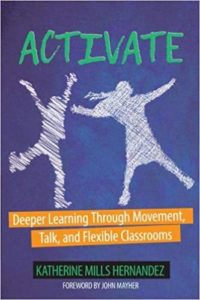Deepen Learning with Movement and More
Activate: Deeper Learning Through Movement, Talk, and Flexible Classrooms
By Katherine Mills Hernandez
(Stenhouse, 2018 – Learn more)
Reviewed by Elisa Waingort

Hernandez contends that movement is not only necessary for learning to take place and to stick, it is also critical to one’s health.So why was I slow to accept her argument and evidence? I’ll start by recounting a personal story.
In 2019 I was diagnosed with stage 4 lymphoma. That same year, I underwent chemo and an autologous stem cell transplant. I was bed-ridden and stationary for a long time. In order to preserve some of my dignity in this public space let’s just say this lasted for months.
Although I’m cancer free now, my mobility has shrunk to the rooms in my house due to COVID and teaching online. I wear my FitBit to track my steps, but that is an exercise in futility because my step count is woefully low from what it used to be, let alone what it should be. Let’s just say, I sit. A lot.

This is to say that Katherine’s book is valuable on a personal and professional level. Take her words to heart; you won’t regret it.
Keys to engagement: Movement, talk and space
If the crux of deep learning is engagement, then what can teachers do to make sure that students are processing and assimilating the learning they do in the classroom (or online)?
Hernandez, a veteran classroom teacher, says: “We’ll need to activate students’ executive function…and involve our students in tasks that align their physical actions (things they do – such as reading, talking, writing, using manipulatives, creating, building, and so on) with cognitive processing of course content.”
How can we be strategic in our use of movement, talk and space to support student learning?
What science says
As all good books do, Activate starts with the author’s journey towards understanding the relationship between physical movement and cognition. Chapter 2 is a brief recounting of the relationship between physical movement and cognitive functioning.
“If exercise makes the brain grow, particularly in the area that affects learning and memory, then teachers and students have new reason to get their bodies moving through the school day” (p. 17).
There is scientific research that proves how exercise ‘primes the brain for learning’ (p.19). And, how talk allows our brain to make connections so that learning can happen.
Linking learning to movement in class
Chapter 3 takes us through different strategies or ways to incorporate more talk and movement in the classroom to increase learning and well-being. In order to do that, we also need to consider the classroom space.
One strategy, among many (see p. 52, 57-59, 62-63), is to use the first five minutes of class time for students to pair up and discuss a warm-up question while walking around the classroom as they talk. Or students can do twenty jumping jacks at their desk, and then as they stand and unpack for the day they can listen to instructions or chat with their classmates.
But these are not just random calisthenics! All movement needs “to link the content of the activities to the content of the course or day’s lesson” (p. 52). Now, that is a game changer! And…the author emphasizes: “One thing to keep in mind is that using brief bouts of movement and talk throughout the class period, rather than implementing them after learning and work times are over, is most beneficial for student learning” (p. 63).
Talk and movement aren’t enough, however. They have to be supported by the classroom environment. So how do we make the spaces in our classrooms amenable to talk and movement? In other words, how do we arrange, organize, and structure the space in our classrooms to allow for movement, talk and just the right amount of stimulation to get those dendrites activated? Chapter 4 addresses the classroom space as well as the benefits of introducing a bit of novelty into the environment.
Chapter 5 is all about what we traditionally think of as “classroom management,” which is really about classroom engagement. And this takes us full circle to what I see is the main purpose of this book: to engage students in learning by intentionally creating classroom spaces that serve as catalysts for movement and talk.
A timely resource for students now and in the future
In this year of COVID learning – virtual, hybrid and in-person – Activate is an important contribution to teacher professional learning. In the words of author Katherine Hernandez, our job as teachers is to help students “understand how their bodies and brains work, and it means helping them find their own voices and honor their own experiences and perspectives. It means helping them learn to listen well and honor others’ experiences and perspectives” (p. 160).
If we are successful, we will have prepared our students for life in the present and in the future.
Elisa Waingort has been teaching in bilingual settings for more than 30 years in public and international schools in North and South America and has long been active in leadership roles in the National Council of Teachers of English (NCTE). Now living in Calgary, Alberta, Canada, she is currently a grades 4 & 5 Spanish bilingual teacher with the Calgary Board of Education. Elisa blogs at A Teacher Musing Out Loud. Her professional Twitter handle is @elisaw5.






























